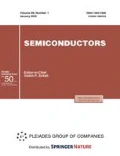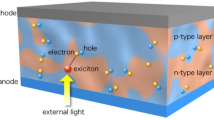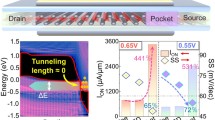Abstract
With the continuous development of optoelectronic devices, parasitic capacitance of electrostatic protection device in the optoelectronic control circuit has become an important factor affecting its response speed. This work designs and manufactures a novel light-controlled dual-directional gate silicon-controlled rectifier (LDGSCR) to study the relationship between light and parasitic capacitance based on 0.18-μm bipolar—complementary metal-semiconductor—double-diffused metal-oxide semiconductor process. The capacitance characteristics of LDGSCR is predicted and verified based on basic principles of the device, 3D device simulation, and capacitance–voltage characteristic C(V) test result. The results show that parasitic capacitance of LDGSCR is affected by both light and bias voltage due to selectivity of J2 junction to light wavelength. The parasitic capacitance of LDGSCR is interestingly divided into three stages of change as voltage increases under light, and the magnitude of capacitance increase varies with the change of light wavelength. In addition, the influence of darkness and light intensity on the parasitic capacitance of LDGSCR is studied. Finally, an optimal adjustment method that balances design windows of novel device and operating frequency of circuit is proposed. This work provides suggestions for the study of capacitance characteristics of light-controlled electrostatic protection devices.











Similar content being viewed by others
REFERENCES
M. D. Ker and S. H. Chen, Solid-State Circuits 42, 1158 (2007).
S. Voldman, ESD: Circuits and Devices (Wiley, New York, 2006).
Y. Wang, X. L. Jin, Y. Peng, J. Luo, J. Yang, Z. W. Zheng, L. Y. Jiang, and Z. Y. Zhong, IEEE J. Emerg. Sel. Top. Power Electron. 99, 1 (2019).
M. D. Ker and K. C. Hsu, IEEE Trans. Dev. Mater. Reliab. 5, 235 (2005).
Y. Wang, X. L. Jin, Y. Peng, J. Luo, and J. Yang, IEEE Trans. Power Electron. 35, 4669 (2020).
V. A. K. Temple, IEEE Trans. Electron Dev. 28, 860 (2005).
C. Richier, P. Salome, G. Mabboux, I. Zaza, A. Juge, and P. Mortini, in Proceedings of the Electrical Overstress/Electrostatic Discharge EOS/ESD Symposium (2000), p. 251.
W. K. Choi, D. G. Kim, Y. T. Moon, Y. W. Choi, Y. K. Kim, K. D. Choquette, S. Lee, and D. H. Woo, Appl. Phys. Lett. 89, 121117 (2006).
S. L. Rumyantsev, M. E. Levinshtein, T. Saxena, M. S. Shur, L. Cheng, J. W. Palmour, and A. Agarwal, Semicond. Sci. Technol. 29, 115003 (2014).
V. I. Murygin, A. U. Fattakhdinov, D. A. Loktev, and V. B. Gundyrev, Semiconductors 41, 1189 (2007).
W. B. T. Simon, P. Migliorato, O. K. B. Lui, and M. J. Quinn, IEEE Trans. Electron Dev. 46, 134 (1999).
C. Y. Lin, M. D. Ker, and G. X. Meng, IEICE Trans. Electron 91, 1321 (2008).
Y. Wang, X. L. Jin, S. G. Cao, Y. Peng, and J. Luo, IEEE Photon. J. 12, 6801711 (2020).
A. S. Shashkina and S. D. Hanin, Semiconductors 53, 838 (2019).
Y. W. Chang, H. W. Chang, T. C. Lu, Y. C. King, W. Ting, Y. J. Ku, and C. Y. Lu, IEEE Electron Dev. Lett. 27, 390 (2006).
Funding
This work is supported by the National Natural Science Foundation of China (grant no. 61827812), Hunan Science and Technology Department Huxiang High-level Talent Gathering Project (grant no. 2019RS1037) and Hunan Innovation project of Science and Technology Department of Hunan province (grants nos. 2020GK2018, 2019GK4016, and 2020RC1003).
Author information
Authors and Affiliations
Corresponding author
Ethics declarations
The authors state that they have no conflict of interest.
Rights and permissions
About this article
Cite this article
Yan, F., Wang, Y., Jin, X.L. et al. Analysis and Measurement of Capacitance Characteristics of a Novel Light-Controlled Dual-Directional Gate Silicon-Controlled Rectifier. Semiconductors 55, 262–271 (2021). https://doi.org/10.1134/S1063782621020214
Received:
Revised:
Accepted:
Published:
Issue Date:
DOI: https://doi.org/10.1134/S1063782621020214




